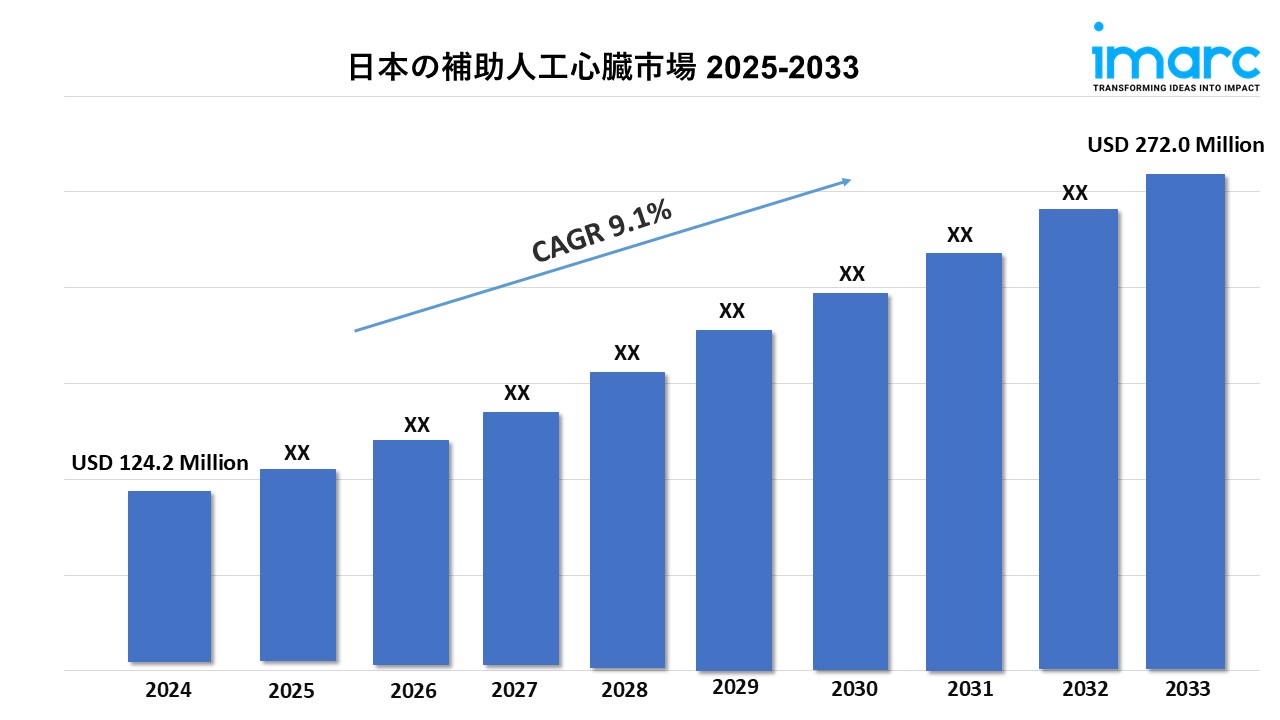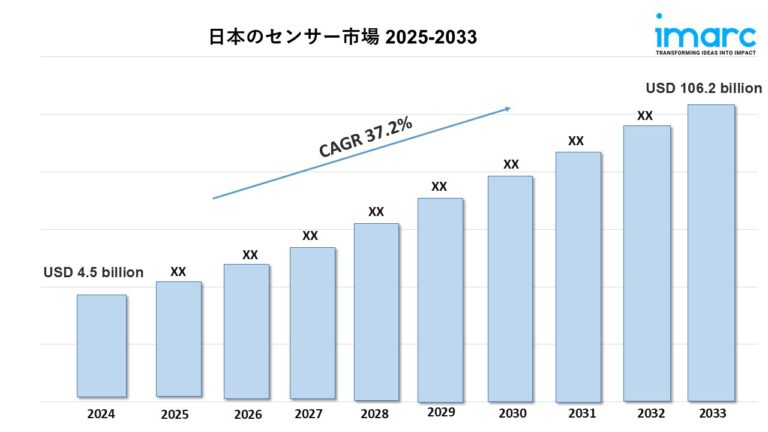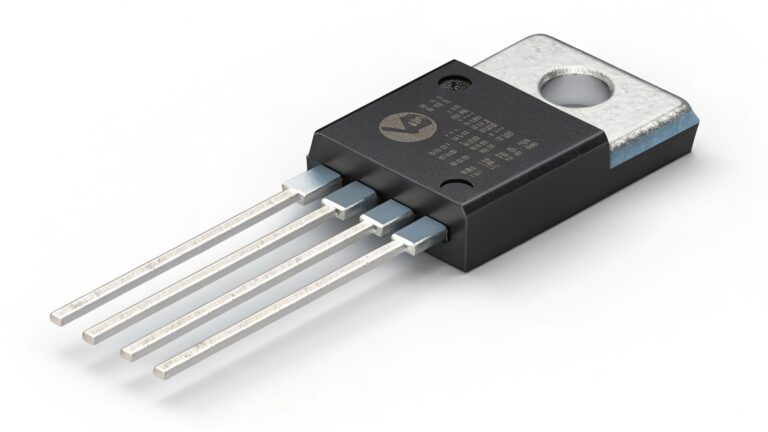
Japan Ventricular Assist Devices Market Size and Growth Overview (2025-2033)
Market Size in 2024: USD 124.2 Million
Market Forecast in 2033: USD 272.0 Million
Market Growth Rate 2025-2033: 9.1%
According to the latest report by IMARC Group, “The Japan ventricular assist devices market size reached USD 124.2 Million in 2024. Looking forward, IMARC Group expects the market to reach USD 272.0 Million by 2033, exhibiting a growth rate (CAGR) of 9.1% during 2025-2033.”
Download a sample PDF of this report: https://www.imarcgroup.com/japan-ventricular-assist-devices-market/requestsample
How AI is Reshaping the Future of the Japan Ventricular Assist Devices Market
Artificial intelligence is transforming ventricular assist device technology by enabling intelligent monitoring systems, predictive maintenance algorithms, and personalized therapy optimization that significantly improve patient outcomes and device longevity. AI-powered remote monitoring platforms continuously analyze data streams from implanted VADs, including pump speeds, flow rates, power consumption, and physiological parameters, detecting subtle anomalies that may indicate device malfunctions, thrombosis formation, or infection development before clinical symptoms manifest. Machine learning models trained on thousands of patient cases identify patterns correlating with adverse events, enabling proactive interventions that prevent complications and reduce emergency hospitalizations. Natural language processing systems analyze patient-reported symptoms, medication adherence data, and lifestyle factors to provide comprehensive health assessments that inform clinical decision-making and personalized care plan adjustments.
The integration of AI in VAD design and patient selection is revolutionizing how cardiac surgeons and cardiologists approach advanced heart failure treatment strategies. Advanced simulation models powered by artificial intelligence evaluate patient-specific anatomical characteristics, hemodynamic profiles, and comorbidity patterns to predict surgical outcomes and device compatibility, optimizing patient selection for VAD implantation procedures. AI-driven optimization algorithms assist engineers in developing next-generation devices with improved biocompatibility, reduced thrombogenicity, and enhanced durability by analyzing vast datasets from clinical trials, material science research, and computational fluid dynamics simulations. Furthermore, artificial intelligence facilitates personalized pump speed programming that adapts to individual patient activity levels, physiological demands, and cardiac recovery progression, maximizing therapeutic benefits while minimizing complications associated with suboptimal device settings.
The convergence of AI and VAD technology is accelerating innovations in bridge-to-recovery therapies and destination therapy outcomes for end-stage heart failure patients. Predictive analytics identify patients with myocardial recovery potential by analyzing biomarkers, imaging data, and hemodynamic trends, enabling targeted interventions that increase explantation success rates. AI-enhanced rehabilitation programs adapt exercise protocols and lifestyle recommendations based on continuous performance monitoring and recovery trajectories. Japanese medical device manufacturers are leveraging artificial intelligence to develop fully integrated cardiac support systems featuring automated flow adjustments, wireless connectivity, and intelligent alert systems that enhance patient quality of life while reducing caregiver burden, positioning Japan at the forefront of advanced mechanical circulatory support innovation and establishing new standards for heart failure management globally.
Japan Ventricular Assist Devices Market Trends & Drivers
The Japan ventricular assist devices market is experiencing steady growth driven by the aging population and increasing prevalence of advanced heart failure requiring mechanical circulatory support. Japan has one of the world’s longest life expectancies, resulting in a growing elderly population susceptible to cardiovascular diseases and end-stage heart failure. The limited availability of donor hearts for transplantation, with waiting lists often exceeding two years, creates significant demand for VADs as bridge-to-transplant solutions that sustain critically ill patients awaiting suitable organs. Additionally, the expanding use of VADs as destination therapy for patients ineligible for transplantation due to age, comorbidities, or contraindications is broadening the addressable patient population. Advances in device technology producing smaller, more reliable, and less invasive VADs with improved hemocompatibility are making mechanical circulatory support viable for broader patient demographics, including older individuals previously considered unsuitable candidates.
The improving clinical outcomes, enhanced quality of life, and expanding reimbursement coverage are driving physician adoption and patient acceptance of VAD therapy. Modern continuous-flow ventricular assist devices demonstrate superior durability, reduced complication rates, and improved survival statistics compared to earlier pulsatile devices, with many patients achieving multi-year support with acceptable quality of life. Japanese healthcare providers are developing comprehensive VAD programs featuring multidisciplinary teams, specialized training, and patient support services that optimize outcomes and manage complications effectively. Government health insurance coverage for VAD implantation and ongoing management costs, combined with manufacturer patient assistance programs, is reducing financial barriers to treatment access. Furthermore, successful patient outcomes and growing awareness among cardiologists and cardiac surgeons about VAD benefits are accelerating referrals and expanding the number of medical centers offering advanced mechanical circulatory support services across Japan.
Japan Ventricular Assist Devices Industry Segmentation:
The report has segmented the industry into the following categories:
Breakup by Product:
- Left Ventricular Assist Device (LVAD)
- Right Ventricular Assist Device (RVAD)
- Biventricular Assist Device (BiVAD)
- Others
Breakup by Flow Type:
- Pulsatile Flow
- Non-Pulsatile or Continuous Flow
Breakup by Design:
- Implantable Ventricular Assist Devices
- Non-Implantable Ventricular Assist Devices
Breakup by Application:
- Bridge-to-Transplant (BTT) Therapy
- Destination Therapy
- Bridge to Recovery and Bridge to Candidacy
Breakup by End User:
- Ambulatory Surgery Centers
- Hospital
- Others
Breakup by Region:
- Kanto Region
- Kinki Region
- Central/ Chubu Region
- Kyushu-Okinawa Region
- Tohoku Region
- Chugoku Region
- Hokkaido Region
- Shikoku Region
Request a Customized Version of This Report for Deeper Insights: https://www.imarcgroup.com/request?type=report&id=19048&flag=E
Competitive Landscape:
The market research report offers an in-depth analysis of the competitive landscape, covering market structure, key player positioning, top winning strategies, a competitive dashboard, and a company evaluation quadrant. Additionally, detailed profiles of all major companies are included.
Recent News and Developments in Japan Ventricular Assist Devices Market
- In July 2025, the 31st Annual Meeting of the Japanese Association of Cardiac Rehabilitation (JACR) was held from July 19–20, at Port Messe Nagoya, Japan. It covers various topics, including Ventricular assist devices and Heart transplantation.
Future Outlook
The Japan ventricular assist devices market is positioned for sustained growth as technological innovations and clinical evidence continue to expand therapeutic applications and improve patient outcomes. Next-generation devices featuring full implantability, wireless power transmission, and extended durability will enhance patient quality of life and reduce complication rates. The integration of artificial intelligence, remote monitoring, and telemedicine will transform post-implant care, enabling personalized therapy management and early intervention for complications. Growing physician expertise, expanding hospital programs, and continued reimbursement support will increase treatment accessibility across Japan’s regions. As VAD technology evolves from emergency intervention to standard care for advanced heart failure, Japan’s commitment to medical innovation positions the nation as a leader in mechanical circulatory support development and clinical excellence.
Key highlights of the Report:
- Market Performance (2019-2024)
- Market Outlook (2025-2033)
- COVID-19 Impact on the Market
- Porter’s Five Forces Analysis
- Strategic Recommendations
- Historical, Current and Future Market Trends
- Market Drivers and Success Factors
- SWOT Analysis
- Structure of the Market
- Value Chain Analysis
- Comprehensive Mapping of the Competitive Landscape
Note: If you require specific details, data, or insights that are not currently included in the scope of this report, we are happy to accommodate your request. As part of our customization service, we will gather and provide the additional information you need, tailored to your specific requirements. Please let us know your exact needs, and we will ensure the report is updated accordingly to meet your expectations.
About Us:
IMARC Group is a global management consulting firm that helps the world’s most ambitious changemakers to create a lasting impact. The company provides a comprehensive suite of market entry and expansion services. IMARC offerings include thorough market assessment, feasibility studies, company incorporation assistance, factory setup support, regulatory approvals and licensing navigation, branding, marketing and sales strategies, competitive landscape and benchmarking analyses, pricing and cost research, and procurement research.
Contact Us:
IMARC Group
563-13 Kamien, Iwata City Country, SHIZUOKA, JP, 4380111
+1-631-791-1145






